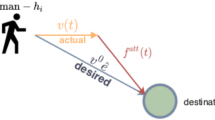Abstract
This paper treats the problem of social navigation and human–robot interaction. In most previous works addressing this issue, the proxemia concept has been considered static with regards to the activity’s nature. Furthermore, the F-Formation type is not considered. The different activities of people can not be considered similarly. For example, the way to navigate socially without disturbing a group drinking coffee or discussing a poster is different, just like the interaction location when serving coffee or explaining a poster. The main contribution of this paper is to propose a dynamic proxemia modeling approach “DPMA” for social navigation and interaction. It is based on proxemia and spatial modeling, which allow the robot to navigate socially by considering the comfort of people, and to interact in appropriate interaction conditions. It considers the F-Formation type and the nature of the activity, additionally to the different social spaces and the navigation and interaction constraints. Then, it uses a social map to encode them. The performance and the efficiency DPMA are evaluated both in three simulation environments using the ROS Stage simulator and on a real robot used as a service robot in a mediation event example. Promising results are given in this paper.






























Similar content being viewed by others
Explore related subjects
Discover the latest articles, news and stories from top researchers in related subjects.References
Hall E (1966) The hidden dimension, vol 6, no 1. Doubleday, Garden City
Kendon A (2010) Spacing and Orientation in Co-present Interaction. In: Esposito A, Campbell N, Vogel C, Hussain A, Nijholt A (eds) Second COST 2102. LNCS, vol 5967. Springer, Heidelberg, pp 1–15
Karami AB (2011) Modèles Décisionnels d’Interaction Homme-Robot. PhD Thesis report. University of Caen Basse-Normandie
Breazeal C (2000) Sociable machines: expressive social exchange between humans and robots. PhD thesis, Massachusetts Institute of Technology, Department of Electrical Engineering and Computer Science, Cambridge, MA
Goodrich MA, Schultz AC (2007) Human–robot interaction: a survey. Found Trends Hum Comput Interact 1(3):203–275
Kirby R (2010) Social robot navigation. PhD Thesis, Robotics Institute, Carnegie Mellon University, Pittsburgh, PA
Svenstrup M, Tranberg S, Andersen HJ, Bak T (2009) Pose estimation and adaptive robot behaviour for human–robot interaction. In: IEEE international conference on Robotics and Automation Kobe International Conference Center, Japan
Yoda M, Shiota Y (1997) The mobile robot which passes a man. In: Procs of the 6th IEEE International workshop on Robot and Human communication, RO-MAN, pp 112–117
Pandey AK, Alami R (2010) A framework towards a socially aware mobile robot motion in human-centered dynamic environment. In: IEEE/RSJ 2010 international conference on Intelligent Robots and Systems IROS 2010—conference proceeding, pp 5855–5860
Chen W, Zhang T, Zou Y (2018) Mobile robot path planning based on social interaction space in social environment. Int J Adv Robot Syst 15(3):1–10
Kuderer M, Kretzschmar H, Sprunk C, Burgard W (2012) Featurebased prediction of trajectories for socially compliant navigation. In: Robotics science and systems (RSS). Sydney, Australia
Ferrer G (2013) Social robot navigation. PhD Thesis
Ramirez OAI, Khambhaita H, Chatila R, Chetouani M, Alami R (2016) Robots learning how and where to approach people. In: IEEE 25th international Symposium on Robot and Human Interactive Communication, RO-MAN 2016. New York, NY, USA, pp 347–353
Satake S, Kanda T, Glas DF, Imai M, Ishiguro H, Hagita N (2009) How to approach humans?: strategies for social robots to initiate interaction. In: 4th ACM/IEEE international conference on human–robot interaction, HRI 2009. La Jolla, California, USA
Lindner F (2015) A conceptual model of personal space for human-aware robot activity placement. In: IEEE/RSJ international conference on intelligent robots and systems (IROS) congress center Hamburg
Riccio F, Capobianco R, Nardi D (2016) Learning human–robot handovers through STAM: policy improvement with spatio-temporal affordance maps. In: IEEE-RAS 16th international conference on humanoid robots (Humanoids), pp 857–863
Rios-Martinez J, Spalanzani A, Laugier C (2011) Understanding human interaction for probabilistic autonomous navigation using Risk-RRT approach. In: IEEE/RSJ international conference on intelligent robots and systems, pp 2014–2019
Michalowski MP, Sabanovic S, Simmons R (2006) A spatial model of engagement for a social robot. In: 9th IEEE international workshop on advanced motion control, pp 762–767
Truong XT, Ngo TD (2016) Dynamic social zone based mobile robot navigation for human comfortable safety in social environments. Int J Soc Robot 8(5):663–684
Charalampous K, Kostavelis I, Gasteratos A (2016) Robot navigation in large-scale social maps: an action recognition approach. Expert Syst Appl 66:261–273
Bellarbi A, Mouaddib A, Achour N, Ouadah N (2020) Dynamic proxemia modeling approach (DPMA) for navigation and interaction with a group of persons. In: The 35th ACM/SIGAPP symposium on applied computing SAC 2020. Brno, Czech Republic, pp 826–828
Dijkstra EW (1959) A note on two problems in connection with graphs. Numer Math 1:269–271
Author information
Authors and Affiliations
Corresponding author
Additional information
Publisher's Note
Springer Nature remains neutral with regard to jurisdictional claims in published maps and institutional affiliations.
Supplementary Information
Below is the link to the electronic supplementary material.
Supplementary material 1 (wmv 132060 KB)
Rights and permissions
About this article
Cite this article
Bellarbi, A., Mouaddib, Ai., Achour, N. et al. A new approach for social navigation and interaction using a dynamic proxemia modeling. Evol. Intel. 15, 2207–2233 (2022). https://doi.org/10.1007/s12065-021-00633-7
Received:
Revised:
Accepted:
Published:
Issue Date:
DOI: https://doi.org/10.1007/s12065-021-00633-7




